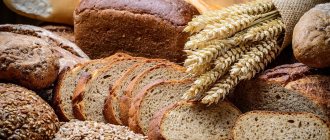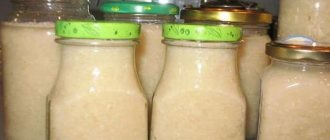Fresh baked goods delight with their softness and aroma, but they become stale very quickly. Sometimes huge stocks of bread accumulate at home. I want to preserve it somehow. An easy way is to make crackers. But they are not suitable for every dish. Easier, faster to freeze. Even in Gaidar’s work “Chuk and Gek” they ate frozen rolls. How relevant is it to preserve product in a chamber?
Let's find out whether it is possible to freeze bread, why they do it, what rules exist. At the same time, we’ll tell you how to return a soft and fragrant bun.
Why freeze bread
You can freeze not only berries, meat, and fish. Bakery products are often subjected to this procedure. Today, many supermarkets offer fresh baked goods. Most work on semi-finished products.
When properly frozen, bread completely retains its taste and aroma. This is a great way to keep baked goods fresh for a long time. If the technology is broken, the product quickly loses its properties, becomes wet, and acquires an unpleasant odor. It cannot be stored for a long time and will definitely not bring any benefit. You can also freeze sour cream and even birch sap.
Do you store bread in the freezer?
Not really
Why freeze bread:
- prolongation of freshness. Rare, expensive, tasty types of bread are easier to store in the freezer. Under room conditions, the product changes the very next day;
- save the surplus. It’s a pity to throw it away, sometimes there’s no one to give it to;
- convenient supplies. Freezing will help if you forgot to buy some bread after work, you returned from vacation, the store near your house is not open, or guests suddenly came.
You can freeze white, dark bread, buns, baguettes, and any other baked goods. The shelf life reaches six months. It is advisable to use it within a month. Defrost in an oven, double boiler, or at room conditions.
Black and white - together or apart?
Grey, black, white: each species has its own individual microflora. And loaves of different types, if placed together, begin to quickly deteriorate.
It is recommended to keep white and black bread apart or pack it in separate bags.
The reasons for the impossibility of storing different varieties together is that white and dark have different amounts of water in the mass of flour. Black contains 80% water, white - about 60%.
In addition, the rich smell of black is absorbed by white loaves.
If wet and moldy spots appear on the pieces, then they are not suitable for food!
How to freeze bread in the freezer for storage
In addition to bread, you can freeze Easter cakes, buns, rolls, and loaves. Absolutely sealed packaging is required. Immediately set the minimum temperature for rapid freezing. Next, we’ll tell you how to keep bread fresh for a long time in the freezer.
White
White baked goods tolerate freezing well. The more baking it contains, the better the taste is preserved.
How to freeze, instructions:
- Cut the loaf into slices. We wrap small buns immediately. We divide the baguettes into several parts.
- Wrap with cling film and make several layers. Or place it in a bag, squeezing out excess air.
- All that remains is to place it on the shelf of the camera and freeze it.
When using a whole loaf, we recommend that you first wrap it in film, then additionally place it in a thick plastic bag and tie it.
Black
Bakery products made from rye flour with fillers are less resistant to storage at sub-zero temperatures. Nuts, dried fruits, and other healthy additives release moisture after thawing. The crumb may spoil. Therefore, you need to freeze only in pieces. When thawing and warming up, excess moisture will immediately evaporate.
The technology is similar - we wrap the slices in film or a bag. Can be placed in a vacuum bag, remove air. We send it to the chamber and freeze it.
After freezing, the glycemic index of bread becomes lower. Starch is less susceptible to the action of digestive enzymes and is poorly absorbed. Great news for diabetics and people with insulin resistance.
Useful tips
To prevent the bread from going stale longer, cut pieces not from the edge, but from the middle: divide the loaf in half, cut the required amount from the middle. Connect the remaining halves with slices, pressing them tightly against each other.
If the bread is slightly stale, you can refresh it. Spray the product with water or wrap it briefly in a damp towel. Then place in an oven preheated to +120 ℃ for 10-15 minutes. The bread will restore freshness and softness for several hours (wheat up to 5 hours, rye up to 9 hours).
To prevent mold, place a handful of salt or an apple slice in the bread bin (they need to be changed periodically). Charcoal wrapped in gauze will get rid of excess moisture and unpleasant odors.
Don’t forget to wash the bread bin once a week and treat it with a weak solution of vinegar (and then dry it thoroughly).
To prevent the bread from getting stale during the festive feast, serve it to the table in a wicker basket, wrapped in a linen towel.
Remember that bread made with yeast-free sourdough is stored better than bread made with yeast dough, as it is less susceptible to the development of fungus. The product will remain fresh longer (7-8 days) if you use vegetable rather than animal fats for cooking.
We hope that our recommendations will be useful to you. How are you used to storing bread? Share your experience in the comments.
Methods for storing bread in the freezer
There are two main ways to freeze bread - whole bread and standard slices. Less often they make fine cuts for crackers. We recommend immediately dividing into pieces for immediate defrosting and consumption. It’s easy to get the right amount at any time; you don’t have to defrost the whole loaf. It is also recommended to freeze ferns, liver pate and other products in portions.
What can you freeze in:
- cling film;
- vacuum bags;
- dense polyethylene.
What you can't do:
- parchment;
- foil;
- hard dishes.
Freezing bread in the freezer
Do not allow moisture, foreign odors, or frost to form. Homemade baked goods are pre-cooled. Otherwise, moisture will form inside the package and the product will spoil.
Foil can be used to wrap plastic-packed slices. It will provide additional protection. In addition to closed packaging, it is necessary to minimize the air gap. Therefore, containers cannot be used. Vacuum bags are ideal.
There is no point in keeping bread in the refrigerator; it is better to freeze it immediately. At a temperature of +5-7 degrees, bakery products continue to become stale and lose their taste. The only thing a refrigerator will protect against is preventing the formation of mold.
Tips for freezing bread
If you plan to eat the loaf of bread in portions, cut the slices to the desired thickness before placing them in the freezer. This will allow you to get the amount you need in the future.
Save time by baking multiple loaves of bread and freezing the slices separately.
Frozen bread
Prepare for the holiday table, prepare your bread and rolls a few weeks before guests arrive, and save your bread. Then defrost them in the refrigerator the night before the event and reheat them just before serving.
See also: Onion buns
Freeze bread dough instead of ready-made breads. This will take up less space and allow you to enjoy freshly baked bread anytime. You can put it in the oven frozen. Just keep an eye on your bread towards the end of its baking, giving it extra minutes if necessary. You may find that it takes an additional 15 minutes to bake.
How long can bread be stored in the freezer?
The shelf life of frozen bread reaches six months. Possible maintenance for up to 7-8 months. Taste qualities are preserved as much as possible for only 3-4 weeks at a temperature of -10-15 degrees. Therefore, it makes no sense to keep it for more than a month. Long-term storage of bread requires a temperature of -18 degrees and below. Not all home cameras are capable of producing it.
Is there a No Frost function? Great! You can freeze bread with it. Accelerating the process helps preserve the quality properties of the product and prevents dampness. This is especially important when using cereals, bran baked goods, rare types with dried fruits, nuts, and seeds.
Storage temperature of bakery products
The optimal temperature for storing buns is from 10 to 25°C. In this case, the loaves should not be left without packaging or other containers; it is best to use a bread box or cloth. Otherwise, conditions will vary depending on the type of baked product.
Wholegrain
Whole grain bread is made from sprouted wheat grains. For storage and consumption, you should choose high quality products. For example, when you purchase flour products, pay attention that the main ingredient in the composition is whole grain flour.
Whole grain bread can be stored for 2 days when opened and 3 days when packaged. Humidity should not exceed 75%, temperature should not exceed 25°C, the place should be dry and well ventilated.
Bezdrozhevoy
Yeast-free bread does not differ in storage conditions from yeast bread. However, its shelf life is up to 10 days, starting from the date of manufacture. In order for the loaf to remain soft for as long as possible, it must be wrapped in the selected material and placed in the bread bin.
Gluten-free
Gluten-free bread does not contain flour that contains gluten. This product is suitable for losing weight, switching to a healthier diet or if you are gluten intolerant.
Freezing is considered the best way to store gluten-free products. The product must be cut into slices, packaged, labeled and placed in the freezer. Before eating, just take out the required amount of bread and heat it in the microwave for 3-5 minutes.
Otrubnoy
A product containing bran, under suitable conditions, retains its nutritional properties for up to 7 days. The best ways to store bran bread are:
- wrapping in paper or plastic bag;
- placement in a bread bin.
Black and white together or separately
Different types of bread have different composition. For this reason, storage conditions and expiration dates will vary.
After one type of loaf goes bad, it will begin to absorb moisture from another. Because of this, both will become stale much earlier than expected.
If mold appears on one bun, it will most likely spread to the other. Therefore, different types of baked goods should be stored separately from each other.
Freshly baked bread
Fresh baked goods require compliance with the following storage rules:
- Ready hot bread must be removed from the mold as soon as possible, then the crust will be crispy.
- Until the loaves have cooled to room temperature, they should not be packaged.
- Use a plastic bag or breathable cloth to wrap your freshly baked loaf. If you are going to use the bread soon, just put it in the bread bin.
Bread crackers
Rusks are dried bread. Dehydrated slices can be seasoned with salt or tossed with sugar, making them a versatile snack or dessert.
Crackers at an optimal humidity level (75%) can be stored for up to 2 years from the date of manufacture. When storing crackers, you should consider some nuances:
- It is best to keep the product in a dark, ventilated place. Do not place it near fresh baked goods or fruits, as they will begin to absorb moisture and quickly deteriorate. Be sure to use storage packaging.
- Dried crackers have a longer shelf life than fried ones. If the product contains food additives, the shelf life is reduced. Snack crackers should be consumed immediately after opening the package.
Why does bread spoil quickly?
Recently, the quality of bread leaves much to be desired - it crumbles and quickly becomes moldy. Previously, it simply became stale, because it consisted only of water and flour. Now the refrigerator has become a second bread bin for many. What is the reason?
It has become normal to use additives, mixtures of emulsifiers, and malts. Some experts say that the white coating on the crust is directly related to the quality of the grain. Others disagree. However, baked goods quickly deteriorate and become moldy. It's a shame. But it turns out there are several reasons.
Good bread can be stored for three days. After this time, it should not have any odor or mold. Sometimes the product itself begins to stale. But often it is not possible to eat a crispy, tasty crust due to a dangerous enemy - mold. Simply cutting it off is not the solution. Why? Let's try to recognize the enemy by sight. Even small mold causes intoxication and serious illness.
This process occurs due to fungal spores floating in the air. It is susceptible to infection more often due to the warm, humid environment. Fungi multiply on the surface, releasing toxins. They appear on cracks. Fungi take root and penetrate inside. Do not eat flour if the mold is visible only on top.
Causes of mold:
- Poor quality raw materials for baking.
- Violation of production technology. Often waste containing mold is used.
- Incorrect conditions, shelf life: temperature, air humidity, oxygen availability.
- Manufacturing method: sponge or unpaired, with sourdough; type and recipe of the product.
- Processing: irradiation, heat treatment, etc.
- Infection with fungal spores during transportation and laying.
- Transmission of fungi through packaging, equipment, clothing, and workers’ hands.
All these points affect the quality
But no less important is what we do with the bread when we bring it home. Homemade bread is no exception
Whether it goes bad often depends on ourselves.
Shelf life and storage of bakery products according to GOST
GOSTs are prescribed with the expectation of selling the product. This means that the product must remain fresh for some time after sale. That is, the shelf life indicated in GOSTs will be slightly less than the actual one. Products are labeled as follows:
- On the packaging of products with a shelf life of no more than 2 days, not only the date, but also the time of packaging of the product is indicated.
- For a product with a longer shelf life, it is acceptable not to provide information about the packaging time, but it is important to indicate the date.
Shelf life of bakery products according to GOST:
| Variety of bread | Storage methods and periods |
| sliced, rye | packaged - 3 days, opened - 24 hours |
| fresh Borodino | 36 hours |
| wheat bread, loaf | packaged - 3 days, opened - 24 hours |
| freshly baked | 1-2 days |
| wholegrain | packed - 3 days, unpacked - 2 days |
| crackers | two month |
| yeast-free | closed - from 7 to 10 days, open - up to 4 days |
| gluten-free | closed - up to 5 days, open - 3 days, frozen - up to 2 months |
| bran | closed - up to 7 days, open - up to 3 days |











